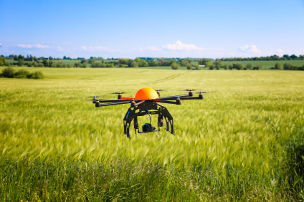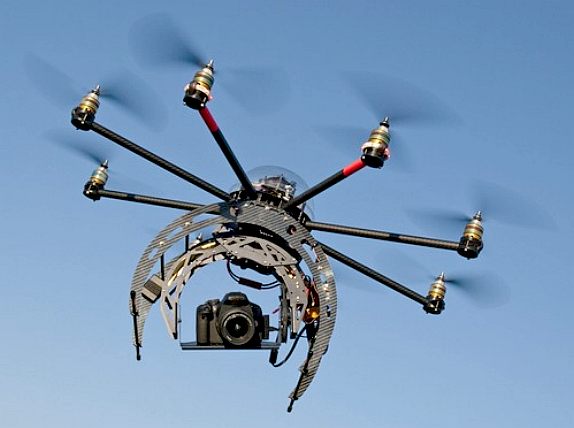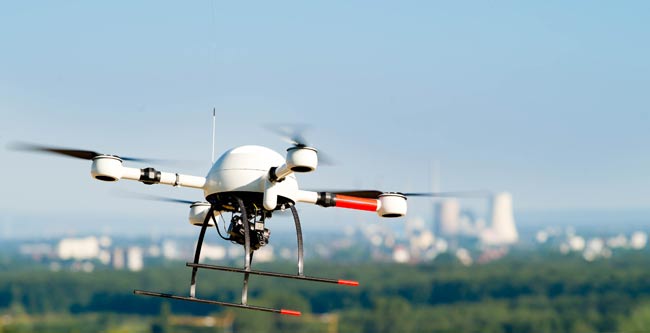November 2015: Unmanned aerial vehicles
Unmanned aerial vehicles (part 1)
There is an increasing number unmanned aerial vehicles (RPAS, also often referred to as drones or Remotely Piloted Aircraft Systems (RPAS)) being operated for various reasons. At the same time there are also regularly reports of incidents with RPAS. The wide distribution of RPAS notwithstanding, they are still banned in Belgium. A communication by Ms Jacqueline Galant, Belgian federal Transport Minister, in which she reveals the main elements of a new Royal Decree, has again stirred public debate on the issue. This debate, however, often neglects to take account of existing international and supra-national frameworks that already contain (binding) regulations on a number of important issues. In our RPAS newsletter series we will examine the key questions that arise concerning authorisation, liability, and the use of images, all of this with respect to both current and future law. The focus here will be on professional use. This issue of the newsletter series is an introduction to the latest legislative developments and authorisation matters.
 When developing a legal framework for RPAS, account must be taken of a number of interests. While the sector emphasises the economic interests, against this must be weighed the issues of airspace and ground safety, as well as the protection of privacy. The fact that these interests are supported in general is illustrated by Communication (2014) 207 of the European Commission. While the Commission on the one hand wants to exploit the growth potential of the sector through the creation of uniform legislation, in the creation of this legislation, protecting the interests of society is of central importance. Alongside the goals to achieve mutual recognition of licenses and to provide financial support for start-ups in the sector, the Commission also wishes to create a clear legal framework with strict safety (compatible with ICAO standards) and privacy rules (conformity to legislation implementing Directive 95/46/EC and Framework Decision 2008/9772). Finally, the Commission aims to develop an appropriate liability scheme. Many RPAS after all fall under the 500-kilogram limit of Regulation 785/2004. In Circular 328, which made recommendations for regulating RPAS, the ICAO makes its central objective: “the highest possible uniform level of safety… this means ensuring the safety of any other airspace user as well as the safety of persons and property on the ground”.
When developing a legal framework for RPAS, account must be taken of a number of interests. While the sector emphasises the economic interests, against this must be weighed the issues of airspace and ground safety, as well as the protection of privacy. The fact that these interests are supported in general is illustrated by Communication (2014) 207 of the European Commission. While the Commission on the one hand wants to exploit the growth potential of the sector through the creation of uniform legislation, in the creation of this legislation, protecting the interests of society is of central importance. Alongside the goals to achieve mutual recognition of licenses and to provide financial support for start-ups in the sector, the Commission also wishes to create a clear legal framework with strict safety (compatible with ICAO standards) and privacy rules (conformity to legislation implementing Directive 95/46/EC and Framework Decision 2008/9772). Finally, the Commission aims to develop an appropriate liability scheme. Many RPAS after all fall under the 500-kilogram limit of Regulation 785/2004. In Circular 328, which made recommendations for regulating RPAS, the ICAO makes its central objective: “the highest possible uniform level of safety… this means ensuring the safety of any other airspace user as well as the safety of persons and property on the ground”.
The objective of ensuring safety must include a preventive component — with rules on authorised uses, areas of operation, training and technical requirements of the device — as well as a curative component, with rules on liability and insurance. However, the sector is afraid that strict rules will make a practical role for RPAS almost impossible. The difficulty in reaching a balance here is also reflected in the fate of the previous draft Royal Decree. In late 2011, Secretary for Mobility Wathelet ordered development of specific regulations concerning the professional use of RPAS in Belgian airspace. A draft Royal Decree was ready in July 2013 (with rules on licensing, training, operations, air traffic rules, medical inspection, maintenance, safety…), but this Decree was modified after consultation with air traffic control company Belgocontrol and the Department of Defence. Then the final result again faced strong criticism from the sector organisation, which believed that the potential for RPAS was (too) severely restricted after the changes. With the arrival of a new government, the draft was put on hold and thus now a new Royal Decree has been announced by Minister Galant, the main lines of which have already been announced.
“The fact that there is no Royal Decree at the moment does not mean that there are not already various rules in place that give answers to important questions on the use of RPAS.”
The fact that there is no Royal Decree at the moment does not mean that there are not already various rules in place that give answers to important questions on the use of RPAS. An important cause of this is the broad definition of an aircraft contained in the many regimes (see further). The result, however, is that these rules, which are actually tailored to manned aircraft, often are not adapted to the specific characteristics of RPAS. This can lead on the one hand to a serious erosion of a number of the principles that were cited above as essential to the protection of safety. On the other hand, they can also raise barriers to the professional use of RPAS. There are also legal rules already in place that govern specific activities. For example, surveillance and data collection — activities that are put forward as potential applications of RPAS — are subject to specific rules. Consequently, current legislation already provides many answers to legal issues that arise in connection with RPAS.
I. Authorisation?
The question concerning authorisation to fly can be divided into several sub-questions: those concerning conditions with respect to the aircraft and its flight, concerning the competence of the pilot (discussed together under the conditions for obtaining a permit), and concerning the need for insurance. A preliminary question, however, is whether it is possible to obtain authorisation to fly a RPAS.
Obtaining an authorisation: the situation under current law
Under article 8 of the Chicago Convention, RPAS may only fly over the territory of a contracting state if they have authorisation to do so. The principled ban on flights also applies above private land within the country itself. The territory of a Member State, after all, includes the airspace above private land, and thus requires a permit. It is important to note that a Member State is under no obligation to grant such authorisation, nor to make authorisation possible or to obtain authorisation.
 The authority to establish rules concerning the use of RPAS in Europe is divided between the European Union and the national governments: while competence for RPAS above 150 kilograms lies with the European Union (EASA) pursuant to Regulations 1592/2002 and 216/2008, that for RPAS below 150 kilograms lies with the national governments, as does competence for unmanned state aircraft. In this regard, the EU aims to develop a legal framework by 2016. An important number of the RPAS, however, are in the less-than-150-kilogrammes category, and the various national governments retain their competence for this category. (art. 4 paragraph 4 Reg. 216/2008 in conjunction with Annex II g) i)).
The authority to establish rules concerning the use of RPAS in Europe is divided between the European Union and the national governments: while competence for RPAS above 150 kilograms lies with the European Union (EASA) pursuant to Regulations 1592/2002 and 216/2008, that for RPAS below 150 kilograms lies with the national governments, as does competence for unmanned state aircraft. In this regard, the EU aims to develop a legal framework by 2016. An important number of the RPAS, however, are in the less-than-150-kilogrammes category, and the various national governments retain their competence for this category. (art. 4 paragraph 4 Reg. 216/2008 in conjunction with Annex II g) i)).
Under article 2 of the Act of 27 June 1937, domestic aircraft traffic over the territory is exempt, subject to the limitations set forth by law or Royal Decree. Article 18 of the Royal Decree of 19 December 2014 states that the use of remote-controlled devices is subject to prior authorisation, but circular CIR/GDF-01 that governs this authorisation is, pursuant to article 1, only applicable to such aircraft that “are used for sports and recreation, that carry neither people nor goods, and that are not engaged in commercial or professional flights.” Thus commercial applications are outside the scope of this circular. In the absence of an authorisation procedure, such flights therefore are, in principle, always prohibited.
To allow scientific developments to continue, the Civil Aviation Authority does issue permits. However, these permits are limited to functional test flights, with the aim of testing the aircraft, payloads or software; training flights with the aim of training pilots, and training concerning payloads; demonstration flights with the aim of showing the aircraft’s capabilities or payload; research flights by universities or scientific institutions for research in the public interest, and finally flights operated by governments. There is still no exception possible for commercial flights: thus they are banned in any case.
Proposals for future regulation
Minister Galant’s proposal takes an entirely different approach. The current proposal makes a distinction between private and professional use.
Private use is exempt from licensing, and flights over private property may take place up to an altitude of 30 meters. The exempt status for private use is somewhat puzzling when judged from the perspective of the above-mentioned balance of interests. All in all, the importance of allowing RPAS for private use is quite limited, with a significant advantage only for the sellers of RPAS, while the impact on safety is quite significant, taking into account the permitted altitude: an object with a mass of 2 kilograms crashing from a height of 30 meters can cause substantial damage. While the law only allows use over private property, it certainly is not inconceivable that, due to circumstances, the RPAS would land outside the private grounds and harm property or persons. We thus advocate the status quo for private use, with authorisation only for model aircraft fields.
For professional use, general authorisation can be obtained for ordinary operations, while a specific application must be submitted for high risk activities that will be handled on a case-by-case basis by the Civil Aviation Authority. The situation for activities with a specific risk is comparable to the situation as it is today. By creating a distinction between regular activities and high-risk activities, this proposal is considerably more flexible than the proposal made by State Secretary Wathelet which requires a notification for each flight.
The area within which flying is possible is still limited, as it was in the proposal of State Secretary Wathelet. Flights are possible only to a height of 300 feet (+/- 90 meters), compared to 60 meters in the Wathelet proposal. According to the press release distributed by Minister Galant, this allows 90% of the planned activities to be carried out, while on the other hand containing no risk of conflict with manned flight at this altitude. However, flying is only possible outside controlled airspace. Where use in military airspace in the Wathelet proposal was also totally forbidden, the present proposal advocates dynamic management, which means that use is permitted provided that airspace is not activated for military use. Importantly, under the current proposal, these limits are also not hard limits: deviations are possible.
Conditions for obtaining a permit
Today the Civil Aviation Authority (DGLV) requires information on the aircraft, the pilot and the flight, and this must include a security file (with emergency scenarios), an operational file, authorisation by the city government and civil liability insurance, but without a legal basis in place that sets common standards for this.
The draft provides for the obligation to register with clear identification of RPAS in order to make it easier to track down those who are liable if needed. Authorisation also requires approval of an operational manual. Concerning the pilot’s qualifications, the proposal advocates a medical exam, sufficient theoretical knowledge and a practical exam administered by examiners designated by the Civil Aviation Authority. Finally, maintaining the license requires 2 hours to be flown annually.
Insurance
 With respect to insurance, however, there are already European regulations in place. Regulation 785/2004 imposes compulsory insurance for aircraft. Again, the question arose whether a RPAS must be understood as an aircraft within the meaning of the Regulation, since article 2 (2) b) excludes model aircraft with an MTOM less than 20 kg. However, the Mid-term Review of the Regulation unequivocally clarified that RPAS (Remotely Piloted Aircraft Systems) fall within the scope of the Regulation, because, again, “the main characteristic of model aircraft is that they are used for sporting and recreational purposes not for commercial, scientific or governmental application”. The review does add that these RPAS in any case must constitute part of a review of the Regulation as there may be a need for a specific framework, and that at least the applicability to RPAS needs be clarified. Due to the applicability of Regulation 785/2004, insurance of 750,000 euro is required, which is the minimum insurance applicable to all aircraft with a MTOM less than 500 kilograms (art. 7.1 Reg. 785/2004). State aircraft are excluded however (art. 2 (2) a.).
With respect to insurance, however, there are already European regulations in place. Regulation 785/2004 imposes compulsory insurance for aircraft. Again, the question arose whether a RPAS must be understood as an aircraft within the meaning of the Regulation, since article 2 (2) b) excludes model aircraft with an MTOM less than 20 kg. However, the Mid-term Review of the Regulation unequivocally clarified that RPAS (Remotely Piloted Aircraft Systems) fall within the scope of the Regulation, because, again, “the main characteristic of model aircraft is that they are used for sporting and recreational purposes not for commercial, scientific or governmental application”. The review does add that these RPAS in any case must constitute part of a review of the Regulation as there may be a need for a specific framework, and that at least the applicability to RPAS needs be clarified. Due to the applicability of Regulation 785/2004, insurance of 750,000 euro is required, which is the minimum insurance applicable to all aircraft with a MTOM less than 500 kilograms (art. 7.1 Reg. 785/2004). State aircraft are excluded however (art. 2 (2) a.).
Moreover, the evaluation also raised the question concerning the insurability of RPAS. In addition, two studies yielded different results: while one found no problem, the other concluded that although it is possible to obtain insurance, the premium for such insurance is ten times higher than normal insurance for aircraft. The causes cited for this were that the market is too small and that the quality requirements for manufacturers of RPAS are lower than for manufacturers of manned aircraft. That second cause could be an important message to the minister: when granting an airworthiness certificate, it might be better to set the bar higher, since this not only has advantages for safety, but over time would also have a favourable impact on the insurance premiums that Belgian companies must pay.
The next issue of our RPAS newsletter series will zoom in on liability matters.
For further information and comment, please contact Arthur Flieger (flieger@fliegerlaw.com, +32 3 238 77 66)
© 2015 A. Flieger – This publication is defined to provide accurate and authoritative information in regard to the subject matter covered. It is transmitted with the understanding that the publisher is not engaged in rendering legal, or any other professional services. If legal advice or other expert assistance is required, professional services should be sought. You can always contact A. Flieger at flieger@fliegerlaw.com.






